Governor of Susa
پوزور-إنشوشيناك𒅤𒊭𒀭𒈹𒂞 تمثال پوزور-إنشوشيناك (lower half of seated ruler) with inscription in his name and victories, particularly over the king of
Shimashki .
[1] العهد c. 2100 ق.م. سبقه خيتا الأسرة ملوك عيلام
كوتيك-إنشوشيناك حكم من
سوسا پوزور-إنشوشيناك (العيلامية الخطية : Puzur Sušinak , Akkadian : 𒌋𒌋𒀭𒈹𒂞 , puzur3 -d , also 𒅤𒊭𒀭𒈹𒂞 , puzur4 -d "Calling Inshushinak "), also sometimes thought to read Kutik-Inshushinak in Elamite ,[3] Elam , around 2100 BC,[4] أسرة أوان according to the Susa kinglist.[5] [6]
In the inscription of the "Table au Lion", he appears as "Puzur-Inshushin(ak) Ensi (Governor) of Susa , Shakkanakku (Military Governor) of the country of Elam " (𒅤𒊭𒀭𒈹𒂞 𒑐𒋼𒋛 𒈹𒂞𒆠 𒄊𒀴 𒈣𒋾 𒉏𒆠 puzur-inshushinak ensi shushiki skakkanakku mati NIMki ) , a title used by his predecessors Eshpum , Epirmupi and Ili-ishmani as governors of the Akkadian Empire for the territory of Elam.[2] [7] Akkadian Empire .[8]
. . . . . . . . . . . . . . . . . . . . . . . . . . . . . . . . . . . . . . . . . . . . . . . . . . . . . . . . . . . . . . . . . . . . . . . . . . . . . . . . . . . . . . . . . . . . . . . . . . . . . . . . . . . . . . . . . . . . . . . . . . . . . . . . . . . . . . . . . . . . . . . . . . . . . . . . . . . . . . . . . . . . . . . .
الحكم His father was Shinpi-khish-khuk, the crown prince, and most likely a brother of king Khita. Kutik-Inshushinak's first position was as governor of Susa, which he may have held from a young age. About 2110 BC, his father died, and he became crown prince in his stead.
Elam had been under the domination of Akkad since the time of Sargon , and Kutik-Inshushinak accordingly campaigned in the Zagros mountains on their behalf. He was greatly successful as his conquests seem to have gone beyond the initial mission. Early on his inscriptions were in Akkadian but over time they came to be also in Linear Elamite .[9]
In 2090 BC, he asserted his independence from king Shar-Kali-Sharri of the Akkadian Empire , which had been weakening ever since the death of Naram-Sin , thus making himself king of Elam.[10] Anshan and managed to unite most of Elam into one kingdom.[10]
According to the inscriptions of Ur-Nammu , Puzur-Inshushinak conquered numerous cities in central Mesopotamia, including Eshnunna and Akkad , and probably Akshak .[11] Gutian territory, gravely weakening them, and making them unable to withstand the Neo-Sumerian revolt of Utu-hengal .[12]
The Elamite name of Puzur-Inshushinak:
Pu-zu-r Šu-ši-na-k in the
Linear Elamite script (right to left).
[13] He built extensively on the citadel at Susa, and encouraged the use of the Linear Elamite script to write the Elamite language . This may be seen as a reaction against Sargon's attempt to force the use of Akkadian . Most inscriptions in Linear Elamite date from the reign of Kutik-Inshushinak.
His achievements were not long-lasting, for after his death the linear script fell into disuse, and Susa was overrun by the Third dynasty of Ur under Ur-Nammu and his son Shulgi .[10] Susa after the demise of Puzur-Inshushinak, and they built numerous buildings and temples there. This control was continued by Shulgi as shown by his numerous dedications in the city-state.[14] Anshan , Marhashi and Bashime .[14] Shimashki dynasty (also Elamite of origin).[15]
It is now known that his reign in Elam overlapped with that of Ur-Nammu of Ur-III ,[16] Gutian dynasty and rule of Utu-hengal of Uruk had not allowed for that synchronism. Ur-Nammu, who styled himself "King of Sumer and Akkad" is probably the one who, early in his reign, reconquered the northern territories that had been occupied by Puzur-Inshushinak, before going on to conquer Susa .[17]
تمثال پوزور-إنشوشيناك The bottom part of a statue, probably representing Puzur-Inshushinak himself, is visible in the Louvre Museum, Sb 55.[18] [19] Shimashki who "kissed his feet".[20]
Inscriptions of the statue of Puzur-Inshushinak (left side)
النقوش A possible mention of Puzur-Inshushinak appears in one of Puzer-Mama's inscriptions,[21] [22] [23]
Dedication by Puzu-Inshunishak in the Akkadian language. Louvre Museum, reference Sb 160.[24]
Linear Elamite inscription of king Kutik-Inshushinak, "Table du Lion", Louvre Museum Sb 17.
Door socket with inscription "Puzur-Inshushinak Ensi of Susa" (𒅤𒊭𒀭𒈹𒂞 𒑐𒋼𒋛 𒈹𒂞𒆠 )
Statue of goddess Narundi dedicated by Puzur-Inshushinak, with inscriptions in Linear Elamite and in Akkadian, Louvre Museum
"Puzur-Inshushinak, Governor of Susa", on the statue of the Goddess Narundi
Perforated stone, with Linear Elamite text. Louvre Museum Sb6 Sb177
Puzur-Inshushinak on the Awan Kings List.[26]
A God putting a foundation nail in the ground, protected by a Lama goddess, in front of a roaring lion. Coiled snake on top. Inscriptions in Linear Elamite and Akkadian . Time of Puzur-Inshushinak, circa 2100 BC, Louvre Museum .[27]
Clay cone with Linear Elamite text. Louvre Museum Sb 17830. Reign of Puzur-Inshushinak.[28]
المراجع
^ Mémoires ^ أ ب Translation into French in Mémoires
^ "Sumerian Dictionary" . oracc.iaas.upenn.edu .^ or from about 2240 to 2220 BC according to the (long chronology )
^ Daniel T. Potts (1999). The Archaeology of Elam
^ Steinkeller, Piotr. "Puzur-Inˇsuˇsinak at Susa: A Pivotal Episode of Early Elamite History Reconsidered" . Susa and Elam. Archaeological, Philological, Historical and Geographical Perspectives. Mémoires de la Délégation en Perse (in الإنجليزية): 293. ^ Mémoires ^ Shayegan, M. Rahim (2011). Arsacids and Sasanians: Political Ideology in Post-Hellenistic and Late Antique Persia ISBN 978-0-521-76641-8 ^ [1] Hall, Harry R., "The Ancient History of the Near East: From the Earliest Times to the Battle of Salamis", Meuthen & Company Limited, 1932^ أ ب ت Hansen, Donald P. (2002). Leaving No Stones Unturned: Essays on the Ancient Near East and Egypt in Honor of Donald P. Hansen ISBN 978-1-57506-055-2
^ "According to one of Ur-Namma's inscriptions, which describes his conflict with Puzur-Inˇsuˇsinak, the latter occupied the cities of Awal, Kismar, and Maˇskan-ˇsarrum, and the lands of Eˇsnuna, Tutub, Zimudar, and Akkade. The prolog to Ur-Namma's code adds to list the northern Babylonian cities of Marda, GIRkal, Kazalu, and probably Ak ˇsak?, plus their rural settlements." in Steinkeller, Piotr. "Puzur-Inˇsuˇsinak at Susa: A Pivotal Episode of Early Elamite History Reconsidered" . Susa and Elam. Archaeological, Philological, Historical and Geographical Perspectives. Mémoires de la Délégation en Perse (in الإنجليزية): 295.
^ Steinkeller, Piotr. "Puzur-Inˇsuˇsinak at Susa: A Pivotal Episode of Early Elamite History Reconsidered" . Susa and Elam. Archaeological, Philological, Historical and Geographical Perspectives. Mémoires de la Délégation en Perse (in الإنجليزية): 298. ^ Zur Entzifferung der altelamischen Inschriften - PDF Free Download ^ أ ب Potts, Daniel T. (2012). A Companion to the Archaeology of the Ancient Near East ISBN 978-1-4051-8988-0
^ Encyclopedia Iranica: Elam - Simashki dynasty, F. Vallat ^ Wilcke; See Encyclopedia Iranica articles AWAN, ELAM
^ Steinkeller, Piotr. "Puzur-Inˇsuˇsinak at Susa: A Pivotal Episode of Early Elamite History Reconsidered" . Susa and Elam. Archaeological, Philological, Historical and Geographical Perspectives. Mémoires de la Délégation en Perse (in الإنجليزية): 298–299. ^ "Site officiel du musée du Louvre" . cartelfr.louvre.fr .^ Mémoires ^ Mémoires ^ CDLI-Archival View ^ Inscription Puzur-Mama E2.12.5.1 in Frayne, Douglas. Sargonic and Gutian Periods
^ Sallaberger, Walther; Schrakamp, Ingo (January 2015). "Philological Data for a Historical Chronology of Mesopotamia in the 3rd Millennium" (in الإنجليزية): 123. ^ Translation of the Akkadian portion into French, in Mémoires
^ Mémoires ^ SCHEIL, V. (1931). "Dynasties Élamites d'Awan et de Simaš". Revue d'Assyriologie et d'archéologie orientale . 28 (1): 1–46. ISSN 0373-6032 . JSTOR 23283945 . ^ Hansen, Donald P. (2002). Leaving No Stones Unturned: Essays on the Ancient Near East and Egypt in Honor of Donald P. Hansen ISBN 978-1-57506-055-2 ^ Louvre, Musée du (1992). The Royal City of Susa: Ancient Near Eastern Treasures in the Louvre ISBN 978-0-87099-651-1
حكام الشرق الأدنى القديم
الأقاليم/[1] [2] [3] [4]
مصر
كنعان إبلا ماري أكشاك /أكاد كيش أوروك أداب أومـّا لگش أور عيلام
سبقها: تأريخ فترة العصر الحجري الحديث
4000–3200 ق.م.
ثقافة نقادة (4000–3100 ق.م.)Proto-Cannaanites
الفترة السومرية (4000–2340 ق.م.)Susa I
Pre-Dynastic period (4000–2900 ق.م.)
Naqada I Naqada II Egypt-Mesopotamia relations
Uruk period Legendary ante-deluvian rulers: Eridu : Alulim , Alalngar , then in Bad-tibira : En-men-lu-ana , En-men-gal-ana , Dumuzid, the Shepherd , then in Larag : En-sipad-zid-ana , then in Zimbir : En-men-dur-ana , then in Shuruppag : Ubara-Tutu flood swept over"[5] Susa II
3200–3100 ق.م.
Proto-Dynastic period Naqada III )
Upper Egypt Finger Snail Fish Pen-Abu Animal Stork Canide Bull Scorpion I Shendjw Iry-Hor Ka Scorpion II نعرمر / Menes
Lower Egypt Hedju Hor Ny-Hor Hsekiu Khayu Tiu Thesh Neheb Wazner Nat-Hor Mekh Double Falcon Wash
3100–2900 ق.م.
Early Dynastic Period First Dynasty of Egypt Narmer Menes Hor-Aha Djer Djet Merneith ♀ Den Anedjib Semerkhet Qa'a Sneferka Horus Bird Canaanites
Jemdet Nasr period Proto-Elamite period Susa III )
Great Flood
2900 ق.م.
Second Dynasty of Egypt Hotepsekhemwy Nebra/Raneb Nynetjer Ba Nubnefer Horus Sa Weneg-Nebty Wadjenes Senedj Seth-Peribsen Sekhemib-Perenmaat Neferkara I Neferkasokar Hudjefa I Khasekhemwy Early Dynastic Period I (2900–2700 ق.م.)
First Eblaite First kingdom of Mari Kish I dynastyJushur , Kullassina-bel Nangishlishma ,En-tarah-ana Babum , Puannum , Kalibum
2800 ق.م.
Kalumum Zuqaqip Atab Mashda Arwium Etana Balih En-me-nuna Melem-Kish Barsal-nuna
Uruk I dynastyMesh-ki-ang-gasher
Enmerkar ("conqueror of Aratta ")
2700 ق.م.
Early Dynastic Period II (2700–2600 ق.م.)
Zamug , Tizqar , Ilku Iltasadum
Lugalbanda Dumuzid, the Fisherman
En-me-barage-si ("made the land of Elam submit")[6]
Aga of Kish Gilgamesh Old Elamite period Indus-Mesopotamia relations
2600 ق.م.
Third Dynasty of Egypt Djoser Sekhemkhet Sanakht Nebka Khaba Qahedjet Huni Early Dynastic Period III (2600–2340 ق.م.)
Sagisu Abur-lim Agur-lim Ibbi-Damu Baba-Damu
Kish II dynastyUhub Mesilim
Ur-Nungal Udulkalama Labashum
Lagash En-hegal Lugalshaengur
Ur A-Imdugud Ur-Pabilsag Meskalamdug Puabi )Akalamdug
Enun-dara-anna Mes-he Melamanna Lugal-kitun
Adab Nin-kisalsi Me-durba Lugal-dalu
2575 ق.م.
Old Kingdom of Egypt Fourth Dynasty of Egypt Snefru Khufu Djedefre Khafre Bikheris Menkaure Shepseskaf Thamphthis Ur I dynasty Mesannepada
2500 ق.م.
Phoenicia (2500-539 ق.م.)
Second kingdom of Mari Ikun-Shamash Iku-Shamagan Ansud Sa'umu Ishtup-Ishar Ikun-Mari Iblul-Il Nizi
Akshak dynasty Unzi Undalulu
Kish III dynasty Ku-Baba
Uruk II dynastyEnshakushanna
Mug-si
Umma I dynastyPabilgagaltuku
Lagash I dynastyUr-Nanshe Akurgal
A'annepada Meskiagnun إلولو بالولو
Awan dynasty Peli Tata Ukkutahesh Hishur
2450 ق.م.
Fifth Dynasty of Egypt Userkaf Sahure Neferirkare Kakai Neferefre Shepseskare Nyuserre Ini Menkauhor Kaiu Djedkare Isesi Unas
Enar-Damu Ishar-Malik
Ush Enakalle
Elamite invasions[7] Shushuntarana Napilhush
2425 ق.م.
Kun-Damu
Eannatum
2400 ق.م.
Adub-Damu Igrish-Halam Irkab-Damu
Urur
Kish IV dynastyPuzur-Suen Ur-Zababa
Lugal-kinishe-dudu Lugal-kisalsi
E-iginimpa'e Meskigal
Ur-Lumma Il Gishakidu Bara-irnun )
Enannatum Entemena Enannatum II Enentarzi
Ur II dynastyMesh-ki-ang-Nanna II
Kiku-siwe-tempti
2380 BCE
Sixth Dynasty of Egypt Teti Userkare Pepi I Merenre Nemtyemsaf I Pepi II Merenre Nemtyemsaf II Netjerkare Siptah Adab dynastyLugalannemundu
2370 ق.م.
Isar-Damu
Enna-Dagan Ikun-Ishar Ishqi-Mari
Invasion of Mari [7]
Ukush
Lugalanda Urukagina
Luh-ishan
2350 ق.م.
Puzur-Nirah Ishu-Il Shu-Sin
Uruk III dynastyLugalzagesi
2340 ق.م.
Akkadian Period (2340–2150 ق.م.)
Akkadian Empire Sargon of Akkad Rimush Manishtushu
Akkadian Governors: Eshpum Ilshu-rabi Epirmupi Ili-ishmani
2250 ق.م.
Naram-Sin Lugal-ushumgal
2200 BCE
First Intermediate Period Seventh Dynasty of Egypt Eighth Dynasty of Egypt Second Eblaite Shakkanakku dynasty Ididish Shu-Dagan Ishma-Dagan Shar-Kali-Sharri
Igigi , Imi , Nanum , Ilulu (3 years)Dudu Shu-turul
Uruk IV dynastyUr-nigin Ur-gigir
Lagash II dynastyPuzer-Mama Ur-Ningirsu I Pirig-me Lu-Baba Lu-gula Ka-ku Hishep-Ratep Helu Khita Puzur-Inshushinak
2150 ق.م.
Ninth Dynasty of Egypt Meryibre Khety Neferkare VII Nebkaure Khety Setut
Neo-Sumerian Period (2150–2000 ق.م.)
Nûr-Mêr Ishtup-Ilum Ishgum-Addu Apil-kin
Gutian dynasty La-erabum Si'um
Kuda (Uruk) Puzur-ili Ur-Utu
Umma II dynastyLugalannatum Ur-Baba Gudea Ur-Ningirsu Ur-gar Nam-mahani
Tirigan
2125 ق.م.
Tenth Dynasty of Egypt Meryhathor Neferkare VIII Wahkare Khety Merykare
Iddi-ilum Ili-Ishar Tura-Dagan Puzur-Ishtar Hitial-Erra Hanun-Dagan [8] Uruk V dynastyUtu-hengal
2100 BCE
Ur III dynasty Ur-Nammu Shulgi Amar-Sin Shu-Sin Ibbi-Sin
2050 ق.م.
2000 ق.م.
Middle Kingdom of Egypt Eleventh Dynasty of Egypt Mentuhotep I Intef I Intef II Intef III Mentuhotep II Mentuhotep III Mentuhotep IV
حوالي 2000 ق.م.
Amorite invasionsElamite invasionsKindattu (Shimashki Dynasty )
2025-1763 ق.م.
Twelfth Dynasty of Egypt Amenemhat I Senusret I Amenemhat II Senusret II Senusret III Amenemhat III Amenemhat IV Sobekneferu ♀
Third Eblaite Ibbit-Lim Immeya Indilimma
Old Assyrian Empire Puzur-Ashur I Shalim-ahum Ilu-shuma Erishum I Ikunum Sargon I Puzur-Ashur II Naram-Sin Erishum II Shamshi-Adad I Ishme-Dagan I Mut-Ashkur Rimush Asinum Ashur-dugul Ashur-apla-idi Nasir-Sin Sin-namir Ipqi-Ishtar Adad-salulu Adasi Bel-bani Libaya Sharma-Adad I Iptar-Sin Bazaya Lullaya Shu-Ninua Sharma-Adad II Erishum III Shamshi-Adad II Ishme-Dagan II Shamshi-Adad III Ashur-nirari I Puzur-Ashur III Enlil-nasir I Nur-ili Ashur-shaduni Ashur-rabi I Ashur-nadin-ahhe I Enlil-Nasir II Ashur-nirari II Ashur-bel-nisheshu Ashur-rim-nisheshu Ashur-nadin-ahhe II
Isin-Larsa period (Amorites )Dynasty of Isin Ishbi-Erra Shu-Ilishu Iddin-Dagan Ishme-Dagan Lipit-Eshtar Ur-Ninurta Bur-Suen Lipit-Enlil Erra-imitti Enlil-bani Zambiya Iter-pisha Ur-du-kuga Suen-magir Damiq-ilishu Dynasty of Larsa : Naplanum Emisum Samium Zabaia Gungunum Abisare Sumuel Nur-Adad Sin-Iddinam Sin-Eribam Sin-Iqisham Silli-Adad Warad-Sin Rim-Sin I (...) Rim-Sin II
Sukkalmah dynasty Siwe-Palar-Khuppak
1894–1595 ق.م.
Second Intermediate Period Thirteenth Dynasty of Egypt Fourteenth Dynasty of Egypt Abraham Biblical )
Yamhad First Babylonian dynasty Amorites )Sumu-abum Sumu-la-El Sin-muballit Sabium Apil-Sin Sin-muballit Hammurabi Samsu-iluna Abi-eshuh Ammi-ditana Ammi-saduqa Samsu-Ditana Early Kassite rulers
Second Babylonian dynastySealand Dynasty ") Ilum-ma-ili Itti-ili-nibi Damqi-ilishu Ishkibal Shushushi Gulkishar m DIŠ+U-ENPeshgaldaramesh Ayadaragalama Akurduana Melamkurkurra Ea-gamil
Sixteenth Dynasty Abydos Dynasty Seventeenth Dynasty
Fifteenth Dynasty of Egypt Hyksos ")Semqen 'Aper-'Anati Sakir-Har Khyan Apepi Khamudi
Mitanni Kirta Shuttarna I Parshatatar
1531–1155 ق.م.
New Kingdom of Egypt Eighteenth Dynasty of Egypt Ahmose I Amenhotep I
Third Babylonian dynasty (Kassites ) Agum-Kakrime Burnaburiash I Kashtiliash III Ulamburiash Agum III Karaindash Kadashman-harbe I Kurigalzu I Kadashman-Enlil I Burnaburiash II Kara-hardash Nazi-Bugash Kurigalzu II Nazi-Maruttash Kadashman-Turgu Kadashman-Enlil II Kudur-Enlil Shagarakti-Shuriash Kashtiliashu IV Enlil-nadin-shumi Kadashman-Harbe II Adad-shuma-iddina Adad-shuma-usur Meli-Shipak II Marduk-apla-iddina I Zababa-shuma-iddin Enlil-nadin-ahi
Middle Elamite period
(1500–1100 ق.م.)Kidinuid dynasty Igehalkid dynasty Untash-Napirisha
Thutmose I Thutmose II Thutmose III
Hatshepsut ♀ Amenhotep II Thutmose IV Amenhotep III Akhenaten Smenkhkare Neferneferuaten ♀ Tutankhamun Ay Horemheb
Hittite Empire
Nineteenth Dynasty of Egypt Ramesses I Seti I Ramesses II Merneptah Amenmesses Seti II Siptah Twosret ♀
Elamite Empire Shutrukid dynasty Shutruk-Nakhunte
1155–1025 ق.م.
Twentieth Dynasty of Egypt Setnakhte Ramesses III Ramesses IV Ramesses V Ramesses VI Ramesses VII Ramesses VIII Ramesses IX Ramesses X Ramesses XI Third Intermediate Period Twenty-first Dynasty of Egypt Smendes Amenemnisu Psusennes I Amenemope Osorkon the Elder Siamun Psusennes II
Phoenicia Kingdom of Israel Saul Ish-bosheth David Solomon
Syro-Hittite states Middle Assyrian Empire Eriba-Adad I Ashur-uballit I Enlil-nirari Arik-den-ili Adad-nirari I Shalmaneser I Tukulti-Ninurta I Ashur-nadin-apli Ashur-nirari III Enlil-kudurri-usur Ninurta-apal-Ekur Ashur-dan I Ninurta-tukulti-Ashur Mutakkil-Nusku Ashur-resh-ishi I Tiglath-Pileser I Asharid-apal-Ekur Ashur-bel-kala Eriba-Adad II Shamshi-Adad IV Ashurnasirpal I Shalmaneser II Ashur-nirari IV Ashur-rabi II Ashur-resh-ishi II Tiglath-Pileser II Ashur-dan II
Fourth Babylonian dynasty ("Second Dynasty of Isin ") Marduk-kabit-ahheshu Itti-Marduk-balatu Ninurta-nadin-shumi Nebuchadnezzar I Enlil-nadin-apli Marduk-nadin-ahhe Marduk-shapik-zeri Adad-apla-iddina Marduk-ahhe-eriba Marduk-zer-X Nabu-shum-libur
Neo-Elamite period (1100–540 ق.م.)
1025–934 BCE
Fifth, Sixth, Seventh, Eighth Babylonian dynasties ("Period of Chaos") Simbar-shipak Ea-mukin-zeri Kashshu-nadin-ahi Eulmash-shakin-shumi Ninurta-kudurri-usur I Shirikti-shuqamuna Mar-biti-apla-usur Nabû-mukin-apli
911–745 ق.م.
Twenty-second Dynasty of Egypt Shoshenq I Osorkon I Shoshenq II Takelot I Osorkon II Shoshenq III Shoshenq IV Pami Shoshenq V Pedubast II Osorkon IV Twenty-third Dynasty of Egypt Harsiese A Takelot II Pedubast I Shoshenq VI Osorkon III Takelot III Rudamun Menkheperre Ini Twenty-fourth Dynasty of Egypt Tefnakht Bakenranef
Kingdom of Samaria Kingdom of Judah
Neo-Assyrian Empire Adad-nirari II Tukulti-Ninurta II Ashurnasirpal II Shalmaneser III Shamshi-Adad V Shammuramat (regent) Adad-nirari III Shalmaneser IV Ashur-Dan III Ashur-nirari V
Ninth Babylonian Dynasty Ninurta-kudurri-usur II Mar-biti-ahhe-iddina Shamash-mudammiq Nabu-shuma-ukin I Nabu-apla-iddina Marduk-zakir-shumi I Marduk-balassu-iqbi Baba-aha-iddina (five kings) Ninurta-apla-X Marduk-bel-zeri Marduk-apla-usur Eriba-Marduk Nabu-shuma-ishkun Nabonassar Nabu-nadin-zeri Nabu-shuma-ukin II Nabu-mukin-zeri Humban-Tahrid dynasty Urtak Teumman Ummanigash Tammaritu I Indabibi Humban-haltash III
745–609 BCE
Twenty-fifth Dynasty of Egypt Black Pharaohs ")Piye Shebitku Shabaka Taharqa Tanutamun
Neo-Assyrian Empire (Sargonid dynasty ) Tiglath-Pileser † Shalmaneser † Marduk-apla-iddina II Sargon † Sennacherib † Marduk-zakir-shumi II Marduk-apla-iddina II Bel-ibni Ashur-nadin-shumi † Nergal-ushezib Mushezib-Marduk Esarhaddon † Ashurbanipal Ashur-etil-ilani Sinsharishkun Sin-shumu-lishir Ashur-uballit II
Assyrian conquest of Egypt
626–539 BCE
Twenty-sixth Dynasty of Egypt Necho I Psamtik I Necho II Psamtik II Wahibre Ahmose II Psamtik III
Neo-Babylonian Empire Nabopolassar Nebuchadnezzar II Amel-Marduk Neriglissar Labashi-Marduk Nabonidus
Median Empire Deioces Phraortes Madius Cyaxares Astyages
539–331 BCE
Twenty-seventh Dynasty of Egypt Achaemenid conquest of Egypt )
Achaemenid Empire Cyrus Cambyses Darius I Xerxes Artaxerxes I Darius II Artaxerxes II Artaxerxes III Artaxerxes IV Darius III
Twenty-eighth Dynasty of Egypt Twenty-ninth Dynasty of Egypt Thirtieth Dynasty of Egypt
Thirty-first Dynasty of Egypt
331–141 BCE
Ptolemaic dynasty Ptolemy I Soter Ptolemy Keraunos Ptolemy II Philadelphus Ptolemy III Euergetes Ptolemy IV Philopator Ptolemy V Epiphanes Cleopatra I Syra (regent) Ptolemy VI Philometor Ptolemy VII Neos Philopator Cleopatra II Philometor Soter Ptolemy VIII Physcon Cleopatra III Ptolemy IX Lathyros Ptolemy X Alexander Berenice III Ptolemy XI Alexander Ptolemy XII Auletes Cleopatra VI Tryphaena Berenice IV Epiphanea Ptolemy XIII Ptolemy XIV Cleopatra VII Philopator Ptolemy XV Caesarion
Hellenistic Period Argead dynasty Alexander I Philip Alexander II Antigonus Seleucid Empire Seleucus I Antiochus I Antiochus II Seleucus II Seleucus III Antiochus III Seleucus IV Antiochus IV Antiochus V Demetrius I Alexander III Demetrius II Antiochus VI Dionysus Diodotus Tryphon Antiochus VII Sidetes
141–30 BCE
Kingdom of Judea Simon Thassi John Hyrcanus Aristobulus I Alexander Jannaeus Salome Alexandra Hyrcanus II Aristobulus II Antigonus II Mattathias
Alexander II Zabinas Seleucus V Philometor Antiochus VIII Grypus Antiochus IX Cyzicenus Seleucus VI Epiphanes Antiochus X Eusebes Antiochus XI Epiphanes Demetrius III Eucaerus Philip I Philadelphus Antiochus XII Dionysus Antiochus XIII Asiaticus Philip II Philoromaeus
Parthian Empire Mithridates I Phraates Hyspaosines Artabanus Mithridates II Gotarzes Mithridates III Orodes I Sinatruces Phraates III Mithridates IV Orodes II Phraates IV Tiridates II Musa Phraates V Orodes III Vonones I Artabanus II Tiridates III Artabanus II Vardanes I Gotarzes II Meherdates Vonones II Vologases I Vardanes II Pacorus II Vologases II Artabanus III Osroes I
30 ق.م.–618 م
Roman Empire Roman conquest of Egypt )Province of Egypt
Roman Empire Judea
Roman Empire Syria
Roman Empire Province of Mesopotamia
Vologases III Parthamaspates Sinatruces II Mithridates V Vologases IV Osroes II Vologases V Vologases VI Artabanus IV
Sasanian Empire Province of Asoristan Ardashir I Shapur I Hormizd I Bahram I Bahram II Bahram III Narseh Hormizd II Adur Narseh Shapur II Ardashir II Shapur III Bahram IV Yazdegerd I Shapur IV Khosrow Bahram V Yazdegerd II Hormizd III Peroz I Balash Kavad I Jamasp Kavad I Khosrow I Hormizd IV Khosrow II Bahram VI Chobin Vistahm
618–628 م
Sasanian Empire Sasanian conquest of Egypt )Province of Egypt Shahrbaraz Sahralanyozan Shahrbaraz
Sasanian Empire Province of Asoristan Khosrow II Kavad II Ardashir III Shahrbaraz Khosrow III Boran Shapur-i Shahrvaraz Azarmidokht Farrukh Hormizd Hormizd VI Khosrow IV Boran Yazdegerd III Peroz III Narsieh
628–641 م
Roman Empire Province of Egypt
Roman Empire يهودا
Roman Empire سوريا
Roman Empire مقاطعة الرافدين
639–651 م
Muslim conquest of Egypt Muslim conquest of the Levant Muslim conquest of Mesopotamia and Persia
حكام آسيا الوسطى القديمة
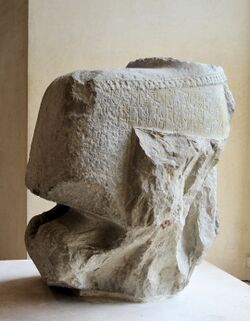
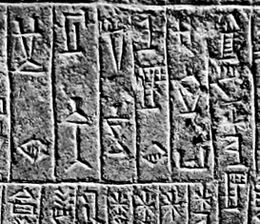
![]() Puzur Sušinak, Akkadian: 𒌋𒌋𒀭𒈹𒂞, puzur3-dinšušinak, also 𒅤𒊭𒀭𒈹𒂞, puzur4-dinšušinak "Calling Inshushinak"), also sometimes thought to read Kutik-Inshushinak in Elamite,[3] was king of Elam, around 2100 BC,[4] and the last from the أسرة أوان according to the Susa kinglist.[5] He mentions his father's name as Šimpi-išhuk, which, being an Elamite name, suggests that Puzur-Inshuhinak himself was Elamite.[6]
Puzur Sušinak, Akkadian: 𒌋𒌋𒀭𒈹𒂞, puzur3-dinšušinak, also 𒅤𒊭𒀭𒈹𒂞, puzur4-dinšušinak "Calling Inshushinak"), also sometimes thought to read Kutik-Inshushinak in Elamite,[3] was king of Elam, around 2100 BC,[4] and the last from the أسرة أوان according to the Susa kinglist.[5] He mentions his father's name as Šimpi-išhuk, which, being an Elamite name, suggests that Puzur-Inshuhinak himself was Elamite.[6]
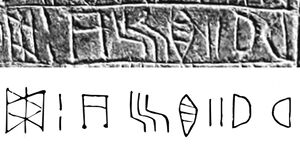
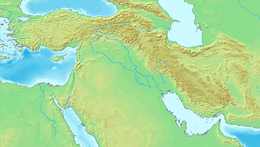

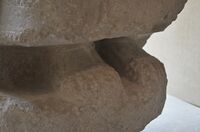
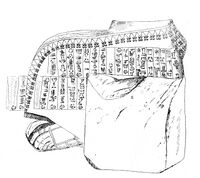
![Dedication by Puzu-Inshunishak in the Akkadian language. Louvre Museum, reference Sb 160.[24]](/w/images/thumb/9/96/Dedication_by_Puzu-Inshushinak_in_the_Akkadian_Language_Louvre_Museum_Sb_160_%2824421024595%29.jpg/200px-Dedication_by_Puzu-Inshushinak_in_the_Akkadian_Language_Louvre_Museum_Sb_160_%2824421024595%29.jpg)
![Bilingual Linear Elamite-Akkadian inscription of king Puzur-Inshushinak "Ensi of Susa". Table of the Lion, Louvre Museum Sb 17.[25]](/w/images/thumb/c/c7/Bilingual_Linear_Elamite_Akkadian_inscription_of_king_Kutik-Inshushinak_Table_of_the_Lion_Louvre_Museum_Sb_17.jpg/200px-Bilingual_Linear_Elamite_Akkadian_inscription_of_king_Kutik-Inshushinak_Table_of_the_Lion_Louvre_Museum_Sb_17.jpg)
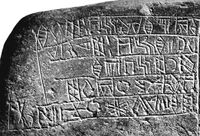
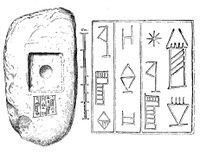
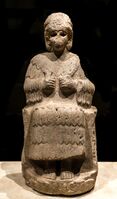
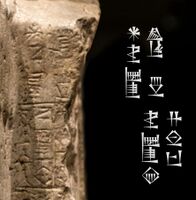
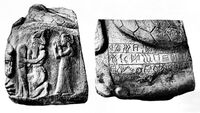
![Puzur-Inshushinak on the Awan Kings List.[26]](/w/images/thumb/1/1b/Puzur-Inshushinak_on_the_Awan_Kings_List.jpg/200px-Puzur-Inshushinak_on_the_Awan_Kings_List.jpg)
![A God putting a foundation nail in the ground, protected by a Lama goddess, in front of a roaring lion. Coiled snake on top. Inscriptions in Linear Elamite and Akkadian. Time of Puzur-Inshushinak, circa 2100 BC, Louvre Museum.[27]](/w/images/thumb/0/02/History_History_4Y1A6592_Louvre_%2824420942315%29.jpg/133px-History_History_4Y1A6592_Louvre_%2824420942315%29.jpg)
![Clay cone with Linear Elamite text. Louvre Museum Sb 17830. Reign of Puzur-Inshushinak.[28]](/w/images/thumb/c/c3/Cone_elamite_lineaire_Sb17830.jpg/170px-Cone_elamite_lineaire_Sb17830.jpg)